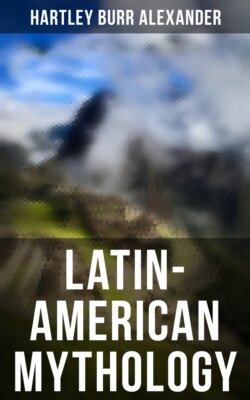Читать книгу Latin-American Mythology - Hartley Burr Alexander - Страница 20
На сайте Литреса книга снята с продажи.
4. Tlaloc and Chalchiuhtlicue36
ОглавлениеThe rain-god, Tlaloc, was less important in myth than in cult. He was a deity of great antiquity, and a mountain, east of Tezcuco, bearing his name, was said to have had from remote times a statue of the god, carved in white lava. His especial abode, Tlalocan, supposed to be upon the crests of hills, was rich in all foods and was the home of the maize-goddesses; and there, with his dwarf (or child) servants, Tlaloc possesses four jars from which he pours water down upon the earth. One water is good and causes maize and other fruits to flourish; a second brings cobwebs and blight; a third congeals into frost; a fourth is followed by dearth of fruit. These are the waters of the four quarters, and only that of the east is good. When the dwarfs smash their jars, there is thunder; and pieces cast below are thunderbolts. The number of the Tlaloque was regarded as great, so that, indeed, every mountain had its Tlaloc.
Like Quetzalcoatl, the god was shown with a serpent-mask, except that Tlaloc's was formed, not of one, but of two serpents; and from the conventionalization of the serpentine coils of this mask came the customary representation of the god's eyes as surrounded by wide, blue circles, and of his lip as formed by a convoluted band from which are fanglike dependencies. The double-headed serpent—a symbol no less wide-spread than the plumed serpent—is frequently his attribute. His association with mountains brought him also into connexion with volcanoes and fire, and it was he who was said to have presided over the Rain-Sun, one of the cosmogonic epochs, during which there rained, not water, but fire and red-hot stones.
The worship of Tlaloc was among the most ghastly in Mexico. Perhaps for the purpose of keeping up the number of his rain-dwarfs, children were constantly sacrificed to him. If we may believe Sahagun, at the feast of the Tlaloque "they sought out a great number of babes at the breast, which they purchased of their mothers. They chose by preference those who had two crowns in their hair and who had been born under a good sign. They pretended that these would form a more agreeable sacrifice to the gods, to the end that they might obtain rain at the opportune time.... They killed a great number of babes each year; and after they had put them to death, they cooked and ate them.... If the children wept and shed tears abundantly, those who beheld it rejoiced and said that this was a sign of rain very near." No wonder the brave friar turns from his narrative to cry out against such horror. Yet, he says, "the cause of this cruel blindness, of which the poor children were victims, should not be directly imputed to the natural inspirations of their parents, who, indeed, shed abundant tears and delivered themselves to the practice with dolour of soul; one should rather see therein the hateful and barbarous hand of Satan, our eternal enemy, employing all his malign ruses to urge on to this fatal act." Unfortunately, it is to be suspected that the rite was very far-spread, for in the myths of many of the wild Mexican tribes and even in those of the Pueblo tribes north of Mexico the story of the sacrifice of children to the water-gods constantly recurs—though, perhaps, this was but the far-cast rumour of the terrible superstition of the south.
The goddess of flowing waters, of springs and rivulets, Chalchiuhtlicue, was regarded as sister of the Tlaloque and was frequently honoured in rites in connexion with them. Like Tlaloc, she played no minor rôle in the calendric division of powers, and she also ruled over one of the "Suns" of the cosmogonic period. Serpents and maize were associated with her, and like the similar deities she had both her beneficent and malevolent moods, being not merely a cleanser, but also a cause of shipwreck and watery deaths. At the bathing of the new-born she was addressed: "Merciful Lady Chalchiuhtlicue, thy servant here present is come into this world, sent by our father and mother, Ometecutli and Omeciuatl, who reside at the ninth heaven. We know not what gifts he bringeth; we know not what hath been assigned to him from before the beginning of the world, nor with what lot he cometh enveloped. We know not if this lot be good or bad, or to what end he will be followed by ill fortune. We know not what faults or defects he may inherit from his father and mother. Behold him between thy hands! Wash him and deliver him from impurities as thou knowest should be, for he is confided to thy power. Cleanse him of the contaminations he hath received from his parents; let the water take away the soil and the stain, and let him be freed from all taint. May it please thee, O goddess, that his heart and his life be purified, that he may dwell in this world in peace and wisdom. May this water take away all ills, for which this babe is put into thy hands, thou who art mother and sister of the gods, and who alone art worthy to possess it and to give it, to wash from him the evils which he beareth from before the beginning of the world. Deign to do this that we ask, now that the child is in thy presence." It is not difficult to see how this rite should have suggested to the first missionaries their own Christian sacrament of baptism.
